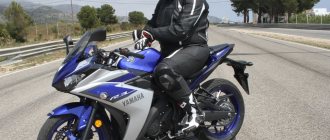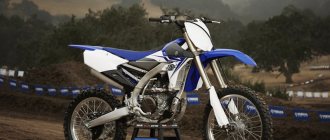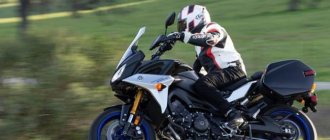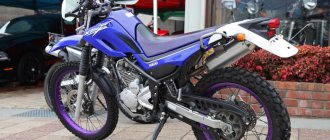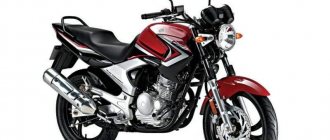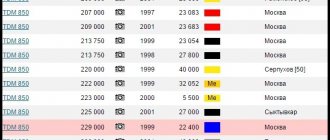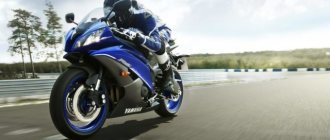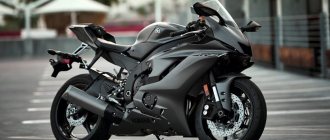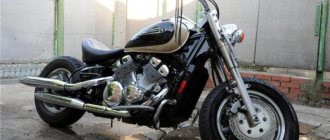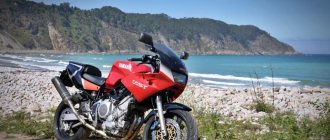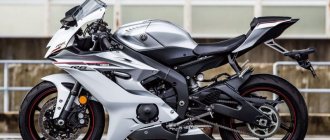The Yamaha YZF R3 model, sales of which started in 2015, became the concern's response to the Kawasaki Ninja 300 motorcycle, which appeared on the market a couple of years earlier.
The budget price, small engine volume, which, nevertheless, is more powerful than that of its competitor, played a role in the popularity of the model.
At the same time, managers especially emphasize that when creating the motorcycle, developments were used that were previously used only on top versions.
Specifications
The main difference from Kawasaki was the slightly larger engine, which had a positive effect on all parameters of the bike. This is a standard 4-stroke engine with 2 in-line cylinders.
The engine provides good dynamics at low and medium speeds, as well as good potential at high speeds.
- Working volume - 321 cm3.
- Power - 42 hp
- Number of valves - 8 (4 per cylinder).
- Cooling is liquid.
- Fuel supply - injector.
- Ignition is electronic.
- Start - electric starter.
- Tank volume - 14 l (including 3 l reserve).
Transmission and clutch
The main drive is a classic chain.
The only nod to modern bikes was the 6-speed gearbox.
Users noted that the gear ratios are selected so that you can drive around the city in first gear. The five others are only for “rocket guys”, which is probably why they are shifted to the very end of the rev range.
- Clutch - multi-disc , oil bath, power transmission - cable .
- The main drive is a chain .
Brakes
Front brakes.
Rear brakes.
Although one would expect drums to be installed on a budget bike, the brakes are nevertheless modern. Hydraulic disc rotors
Front brakes
- Number of disks - 2.
- Diameter - 298 mm.
- Support - 2-piston.
Rear brakes
- Number of disks - 1.
- Diameter - 220 mm.
- Support - 1-piston.
ABS is installed as standard. Such models are labeled YZF-R3A . In American markets you can see the YZF-R3. They are produced to order from American dealers and do not have ABS.
Hello everyone, MotoZak is in touch as always! Those who subscribe to the channel and regularly watch my videos know that I purchased a new Yamaha R3 (now “Mukha”, and you’ll find out why in the video) for the track, but before the first training sessions at the karting track you need to properly break in the engine, as recommended by myself manufacturer. And after a couple of weeks of daily use of this baby, I formed my first impressions, which I will now share!
And according to tradition, the text version (without inserts with jokes, so I recommend watching all of them and the video) The first thing I would like to note and what makes the Erka stand out is the appearance of the motorcycle. If you don’t pay attention to the Izhevsk turn signals, the front part looks very bold and modern, so few people realize that this is just a 300, and comparing it with the Chernysh (Honda CBR600RR) you can feel a big difference between them. It immediately becomes clear where the 2010 model is and where the 2021 is. The Erka is especially good at night, when all that remains is an angry squint, but if you evaluate it from the side or rear, then the compact engine, the exhaust sound, the bicycle wheels and the entire rear end give it away and say, that this is far from P1 or even P6. Although this did not stop me from receiving attention from the fair sex, so guys who buy a motorcycle just for girls, this bike is just for you and you won’t have to spend much. In general, I was satisfied with the ergonomics of the bike, with the exception of the emergency lights. If you, like me, are used to holding on to the edges of the clip-ons, then you need to try very hard to use the emergency lights while moving, because at the same time holding the gas open and reaching for the button with your thumb is completely inconvenient. Therefore, if the P3 rider did not say thank you on the road, then he simply could not reach the button to turn on the emergency lights. The display, even in sunny weather, does not glare and shows information normally; in addition, it is quite informative and you can find out what your average fuel consumption is, turn on the economizer mode, check the mileage after the last oil change, daily mileage, gear indicator and control lamps - oil pressure , abs, neutral light and blipper, which signals that it’s time to upshift. On P3 models from 1919 onwards, the blipper is customizable, it has several visual operating modes - blinking, on and off. You can also select the speed range at which it will operate. I liked all these features, they are useful and convenient. When I took the motorcycle, the fuel consumption was 3.9, and now in the run-in mode it has dropped to 3.6 liters, which is not at all bad. The gas handle has a long stroke and turns very easily, unlike Chernysh. I still find it more pleasant when the throttle opening is tighter and some kind of resistance is felt, and not like fluff. Otherwise, I didn’t find any know-how, everything is the same as on a regular motorcycle, a cable clutch and a regular brake machine with stock levers, which are comfortable. Go ahead. The sound of a motorcycle with a stock can is quiet, only at higher speeds does the parody of the Erka begin. Now I’ve already bought a new jar, but the transformation series will be separate, so subscribe so you don’t miss it. Now about the motorcycle review. Due to the mirrors, in principle, everything is clearly visible, but as soon as the traffic jam starts, the drive becomes uncomfortable due to their flight. It’s good that the Japanese made them foldable and because of this I can actually climb everywhere with ease, and sometimes I even push the sports in front. That’s why they came up with the nickname “Fly” for the erke, who is just as annoying, nimble and fast. By the way, this baby with a light pilot accelerated to 190 km/h, but if we talk about acceleration dynamics, of course it’s not there compared to 600. But in city traffic I didn’t feel disadvantaged. Yes, powerful motorcycles leave traffic lights faster, but then! At the next traffic light I arrive when the signal is green and we drive together again. On the track, in order for the motorcycle to have a good return, it needs to be kept at high speeds and in this riding mode there is quite a strong vibration on the clip-ons, after which the hands begin to itch and get tired. Of course I didn't like this. But the landing on the P3 is very comfortable, you can just ride and ride without getting tired, after using it for a week, when I switched to Chernysh, I realized what a shrimp landing is, although I don’t get tired on the CBR, but the fact remains that on the P3 moving around is even more convenient and comfortable. Due to its low weight, the motorcycle is very sharp and easy to control; you literally move your body a little into the turn and the motorcycle immediately falls into it. I love it when there is such a sharp feedback, but there is another side to the coin... If we are talking about serious angles of inclination of the motorcycle, then any body movement is transmitted to the bike and plays a role in control, so you need to get used to the smoothness of your actions. Do everything quickly, but not abruptly. The motorcycle brakes normally when stock, the ABS even kicked in a couple of times, which is new to me, but definitely a useful thing for novice pilots. I also had time to tinker with the bike a little and pay more attention to the details. I liked that you don’t need to remove the plastic to change the oil; this is a big plus, but otherwise, of course, you can see the savings in my opinion. Everything looks kind of flimsy. If you look at the running boards, the gearbox foot, the brakes, it seems like they are about to break or the metal is bent. I didn’t appreciate the chain tensioning mechanism either, when you loosen the bolts, you start chattering, I don’t know, maybe this is already the norm, but after SBR it seems to me like some kind of Chinese thing. Also with the rear axle, could it be possible to make some kind of clamp? You have to press the wrench against the slide on the other side to unscrew the nut completely. I also have a question about switching speeds from 1st to 2nd, if this is done at low speeds, so as not to strain the engine, so to speak, then quite often the gear is not engaged, so you have to turn it in first gear for at least 6 thousand... Owners of eroks, write is this the norm? In general, these are my first such minor quibbles, but we’ll see what else we’ll have to deal with when we start tuning and preparing for the track. Now let me give you a short summary. I think this motorcycle is, first of all, perfect for a novice girl pilot, the motorcycle is smooth, light, comfortable and does not provoke racing and aggressive riding, but on the other hand, it will quickly get boring with its boredom and if you are a passionate person who loves speed, then you definitely need something more dynamic. Personally, I started my motorcycling career with the SBR600RR and quite normally continue this path, but again, if you know how to control your emotions and are friends with your head, well, nothing can save the crazy ones. I would also take this bike for a daily ride to work or for small errands, generally an excellent option. He eats little, fits everywhere and looks great. These are my first impressions of Mukha, let’s see how she performs on the track! Good luck to everyone, MotoZak is always in touch!
Driving performance
The maximum speed indicated in the documents is 175 km/h . Users who managed to “touch” the new model claim that this is an advertisement.
175 km/h from a hill and with a tailwind. In other conditions the motor will not pull.
Acceleration to hundreds
Acceleration from zero to 100 km/h is also not impressive - 6.5 seconds .
Fuel consumption
If you do not keep the tachometer needle in the red zone, it seems as if the motorcycle is not consuming fuel at all.
Fuel consumption with an average cruiser and a good flat road is 3.8 liters . Mixed - up to 5 l . The specific one depends on the conditions of use.
Dimensions and weight
Fully filled with all fluids and ready for a ride, the bike weighs 169 kg . Dry weight - 150 kg .
Dimensions, as for a small-capacity vehicle, are within the bounds of decency.
- Length - 2,091 mm .
- Width: 721 mm .
- Height - 1,136 mm .
- Seat height - 779 mm .
- Wheelbase - 1,382 mm .
- Ground clearance - 160 mm .
Yamaha YZF-R3 2015 Review
A sportbike for growth for beginners.
, Yamaha has blessed us with a series of successful motorcycles like the MT-09 , FJ-09 and MT-07 , which have proven that cheap and affordable bikes do not have to be boring and underpowered. But that's not all: the company recently introduced the YZF-R1 and R1M , showing what advanced and competitive technologies the manufacturer is ready to provide to its customer base. Add to that Tuning Fork's existing range of street models, and it's clear that Yamaha has a solid portfolio. Only one market segment remains unattended - the company has nothing to offer newcomers. But that's a thing of the past, as Yamaha brought the R3 to market.
Yamaha officials admit there was a gaping hole in the brand's lineup in the novice rider market segment. While Kawasaki with its Ninja "babies" was the leader in this class, Yamaha decided to bide its time. Then Honda released the CBR250R (and soon the CBR300R), but the wait continued.
The Yamaha R3 is perhaps the best-looking beginner motorcycle on the market today. And this is a very important quality for attracting new customers in the hope of turning them into loyal fans of the brand.
With sales increasing in the sportbike segment, Yamaha finally decided it was time to fill the tires of small-displacement sport models. And the goal was quite simple and concise: to make a motorcycle better than the “godfather” of all motorcycles for beginners - the Kawasaki Ninja 300.
"Faster, higher, stronger"
However, this is not as simple as it might seem, since it is no coincidence that the Ninja has gained cult status among motorcycle enthusiasts. It was decided to start with the engine. The 320.6 cc two-cylinder in-line DOHC engine is 25 cc larger than the Kawasaki two-cylinder engine; The cylinder diameter is 68 millimeters (compared to 60 mm for the 250th model), and the piston stroke is 44.2 millimeters. A 1.2-liter air intake plenum feeds a 32mm Mikuni throttle body, while 12-hole injectors deliver atomized fuel. The mixture passes through two 26mm intake valves, where forged aluminum pistons compress the mixture to a ratio of 11.2:1, and after the explosion, two exhaust valves (22.5mm) allow the gases to exit first into a 2 into 1 exhaust system with a three-way catalytic afterburner, and then into the atmosphere.
Like the flagship R1, the R3's cylinders are offset to reduce mechanical losses due to piston and cylinder friction. However, unlike the R1, the R3 uses a more traditional 180-degree crankshaft rather than the 270-degree Crossplane type found on the MT-07. According to Yamaha, the advantage of the Crossplane is that the rider has better control with more horsepower. Since the R3's output is relatively low (about 42 horsepower according to Yamaha Europe), this type of crankshaft is not needed. Additionally, the 180-degree crankshaft makes initial balancing easier.
Under the body of the motorcycle lies a 320.6 cubic centimeter two-cylinder in-line engine with a closed-cycle injection system, four valves per cylinder, aluminum pistons and offset cylinders. However, there is no 270-degree Crossplane crankshaft.
The rest of the design is more traditional, including the fact that the engine serves as a load-bearing element in a steel frame. The pendulum is also made of steel, but not the standard box-section design, but more stylized. Suspension both front and rear from KYB; The 41mm front forks and rear shock absorber with seven-position preload adjustment provide 130 and 125mm of suspension travel respectively. The manufacturer also managed to slightly reduce the weight of the motorcycle through the use of cast aluminum 10-spoke wheels, and Michelin Pilot Street tires (front - 110/70-17, rear - 140/70-17) were developed specifically for the R3. A single 298mm front brake disc is paired with a twin-piston Akebono caliper, while the rear features a 220mm disc with a single-piston caliper.
Not just another motorcycle for beginners
Judging by the manufacturer's statements, the R3 with a fully filled 13-liter gas tank weighs 167 kilograms. That makes it 5.1kg lighter than the Ninja 300 (17-litre tank), but 4.9kg heavier than the CBR300R (12.8-litre tank). Of course, it's hard to tell the difference without having two other bikes side by side on the pavement, but the R3 feels very nimble and narrow between the rider's thighs. The bike was tested both on open roads and on a closed race track.
The driving position on the R3 is comfortable: the steering wheel is high and the footrests are low.
For a bike aimed at novice riders, the R3 is surprisingly good on the road. The clutch release is light and relaxed, and the short first gear allows you to easily leave behind other road users after the traffic light turns green. The transmission's gears are very well spaced, and compared to the Ninja, there is a noticeable difference in power throughout the rev range.
The R3 can easily cruise at speeds of around 130 kilometers per hour in sixth gear, while still having enough rev range to overtake slower road users. Out of curiosity, the test driver slowed down to 40 kilometers per hour without shifting from sixth gear, after which he opened the throttle and the engine revved up smoothly and without problems. The forward motion of the throttle means that novice drivers with heavy, clumsy hands won't get into too much trouble when they go full throttle, but experienced drivers would benefit from a more direct, responsive throttle. However, fuel delivery is excellent. The power of the R3 will be appreciated by both young bikers and veterans: the motorcycle is flexible enough for a beginner, but at the same time it will not get bored for an experienced driver who has decided to switch to something less powerful and crazy.
A single 298mm brake disc up front with a two-piston Akebono caliper does most of the work during braking. Also note the 10-spoke cast aluminum wheels and Michelin Pilot Street tires.
The clip-on steering wheel is located above the crossbar, which makes the driving position sporty, but at the same time quite upright. There's also a bit of seat room for the engine, and the footrests aren't very high. But it must be mentioned that this will definitely be relevant for owners with a height of about 175 centimeters. However, it is not a fact that tall drivers will be uncomfortable, as a couple of test drivers over 180 centimeters tall did not complain of inconvenience.
On twisty parts of the road, the R3's low curb weight and cast aluminum wheels help the bike turn in very easily. The suspension is tuned for a more or less sporty driving mode, and the KYB components do an excellent job. There was one time when they started to lose elasticity and speed on a high-speed section of the road with potholes, but for drivers of the level for which the R3 is designed, the suspension is good. Despite the fact that there is only a single brake disc up front, there were no braking complaints to complain about in street conditions. These aren't the brakes of the R1, of course, but the power and controllability of the system are on par with competitors from Honda and Kawasaki.
Yamaha designers called the R3's styling "R-DNA" with its forward-sweeping silhouette, upswept tail, dual headlights and aerodynamic design a la the R6.
Fun on the track
Although few future R3 owners will take their bikes to the race track, Yamaha gave the press a short test ride on the twisty 3.2-kilometre closed circuit with elevation changes and several low-visibility corners. In general, an ideal testing ground for R3.
With the increasing popularity of small-displacement sportbikes in racing, that small group of riders will be happy to know that the R3 is an excellent track bike for the aspiring rider.
All R-series motorcycles, from small to large, handle well on the race track. R3 is no exception.
The agility and effortless handling that the bike exhibits on the street continues to carry over on the track. The engine gradually gains speed as the speed increases, stopping at approximately 11,500 rpm (the maximum permissible speed is 12,500 rpm). I was especially pleased with how the bike could climb out of slow corners, as on this particular track it was not uncommon to take tight corners in second gear. Sometimes the test driver downshifted completely unsuccessfully, and he had to pass them in third gear. To our surprise, the motor handled the task smoothly.
If we were given the task of making an R3 racer specifically for track racing, we would not leave the tires, suspension, brakes and slipper clutch unnoticed. Michelin Pilot Street tires, as the name suggests, are still designed for city streets. Its composition makes it an excellent tire for the city, as it heats up quickly, but edge grip is satisfactory at best. However, the suspension is well calibrated for the track conditions with these tires on the wheels.
The R3 is a decent track toy, but a few tweaks to the package could bring out the bike's full potential.
With grippier tires, you could brake better, accelerate faster, corner faster, and lean the bike more in corners. This in turn would require stronger compression and rebound damping. Not having much power in the base configuration, the rear end of the bike starts to chatter and slide when you get on the gas while leaning into a corner. Fortunately, the motorcycle immediately makes it clear that it is not easy, and the driver has enough time to slow down.
Another unpleasant point is the lack of a slipper clutch and ABS. This was done to keep the R3's price low, but be aware that downshifting at high speeds requires perfect timing of the revs and careful use of the clutch lever to prevent the rear of the bike from dancing from side to side on the tarmac.
Despite the above, you can still lean over the R3 in its basic configuration, bringing your knee to the asphalt.
Other than the lack of a slipper clutch and ABS, these are all just minor quibbles that you can fix yourself. The R3 is as good on city streets as it is on a closed track, where it will likely even outperform its Japanese competitors.
Catch up and overtake
Yamaha has been slow to release a sportbike for beginners, but the R3 doesn't disappoint. This is a powerful yet well-handling motorcycle that is sure to outperform its Japanese competitors and will be equally appealing to riders of all skill levels. The nimble chassis and low seat height only make it even more attractive.
The motorcycle will be presented in blue-silver, white-red and black colors.
Yamaha YZF-R3 2015 Specification | |
| Three engines | 321cc twin-cylinder DOHC cm.; liquid cooling system; 4 valves per cylinder |
| Bore X Stroke | 68.0 mm. X 44.1 mm. |
| Compression ratio | 11.2:1 |
| Fuel system | Fuel injection |
| Ignition | TCI |
| Transmission | Six-speed constant mesh |
| main gear | Chain |
| Front suspension | Telescopic fork KYB 41 mm; stroke - 130 mm. |
| Rear suspension | KYB single shock absorber; stroke - 124 mm. |
| Front brakes | Hydraulic disc, 298 mm. |
| Rear brakes | Hydraulic disc, 220 mm. |
| Front tire | 110/70-17M/C 54H |
| Rear tire | 140/70-17M/C 66H |
| Length X width X height | 2090 mm. X 718 mm. X 1135 mm. |
| Seat height | 780 mm. |
| Wheelbase | 1379 mm. |
| Rake | 25° |
| Trail | 94 mm. |
| Tank capacity | 14 l. |
| Fuel consumption | 4.2 l. per 100 km. (stated) |
| Weight with all liquids | 167 kg. |
For whom is it intended?
The main users of this motorcycle are beginners with aesthetic needs.
Based on the statement of company representatives that the bike is planned for sales on all continents and in all countries, we can conclude that it was intended for a person of average and tall height .
However, the position of the mirrors and the saddle for the driver clearly indicate that it is better for a tall biker to look for another model.
Modifications
According to the designers, the model was supposed to be better than the development from Kawasaki. The goal has been achieved, no modifications are planned .
However, in 2021, the concern launched the Yamaha MT-0 3, a naked bike for beginners. It is based on the YZF R3.
What I didn't like
The Yamaha YZF R3 has only a few weak points and they can all be easily corrected if they bother you.
I would like to see adjustable levers from the factory , at least the brake lever, because some pilots with small hands may have difficulty. Although Yamaha will sell you an upgraded set, all I'm asking for is the same simple levers they put on the old CBRs and Bandits.
The back part is quite narrow and moisture gets into the back seat , so everything you carry behind your back can get wet and it’s better to pack it all tightly.
Competitors (Comparison)
Kawasaki Ninja 300.
Honda CBR300R.
As the developers themselves admit, they had one main competitor - Kawasaki Ninja 300 . Considering that the model is no longer produced, this can be considered a recognition that Yamaha is still better.
But to complete the picture, here are a few numbers.
| Yamaha YZF R3 | Kawasaki Ninja 300 | Honda CBR300R |
| 2-cylinder | 2-cylinder | 1 cylinder |
| injector | injector (our own development) | injector (our own development) |
| 321 cm³ | 296 cm³ | 286 cm³ |
| 42 hp | 38 hp | 31 hp |
| ABS (optional) | ABS (optional) | combi-break. |
As expected, the YZF R3 was superior in every way compared to the Kawasaki.
Honda's low performance largely depended on the fact that for a long time it assembled small-capacity cars on 1 cylinder , putting speed at the expense of safety and ease of maintenance.
New design of Yamaha R3
Finally, the Yamaha R3 looks like an R sportbike, with new plastics, headlights and tank. He began to look serious, strongly built and complete.
Yamaha YZF-R3 2019
The tank has become lower and wider, but holds the same 14 liters of gasoline. Thanks to the new tank shapes, I fit into the new Yamaha R3 much better than the old one. Yamaha says it's easier to wrap your legs around. Agree. Technically, the "tank" is a plastic cap, so it will be much cheaper to replace than a metal one if you break it.
Both headlights and the taillight are LED, which is nice, but the turn signals have incandescent bulbs - are you serious? Both headlights shine with both low and high beams, and not separately, as on many other motorcycles.
Few will notice elements like the aggressive M-grade intake system or MotoGP-style Magneti-Marelli gauges that make the Yamaha R3 feel like a premium sportbike. But that doesn't matter. You don't have to be an expert to appreciate this motorcycle.
What's new in the engine and chassis?
The 2021 Yamaha YZF R3 has a 321 cc inline twin. see and the diagonal steel frame have not undergone any changes. Yamaha's American division doesn't release engine specs, but their European site says the R3 makes about 41 ponies at 10,750 rpm and just under 30 Nm of torque at 9,000 rpm.
Yamaha got rid of the shortcomings of previous models in a fairly simple way - they made a list of all the shortcomings and simply gradually eliminated them. A proven move.
The old model used bias-ply tires for some reason, but the new bike has Dunlop SPORTMAX GPR-300 radials. They are found on many sport bikes and are arguably the best for racing.
The suspension has also undergone changes. Yamaha has installed a 37mm inverted fork from KYB, which is stiffer than other bikes in its class. Fork rebound damping has increased by 120 percent and compression damping by 380 percent. These sweeping changes promise tighter, clearer governance. The rear suspension has also changed accordingly. There is an upgraded KYB rear shock absorber with seven steps of spring preload adjustment. Rebound damping is up 70 percent and compression damping is down 10 percent. Yamaha initially planned to use an Öhlins fork, but that turned out to be too expensive. But even with such a suspension, the motorcycle outperforms its competitors.
Flaws
- Dynamics.
- Price.
- Normal traction is only in the red zone.
and dignity
This is perhaps one of the best lightweight sports bikes for daily use.
- Low center of gravity.
- The ability to sit not only in a sporty way.
- Maneuverability.
- Compactness.
- Convenient, clear instrument panel.
